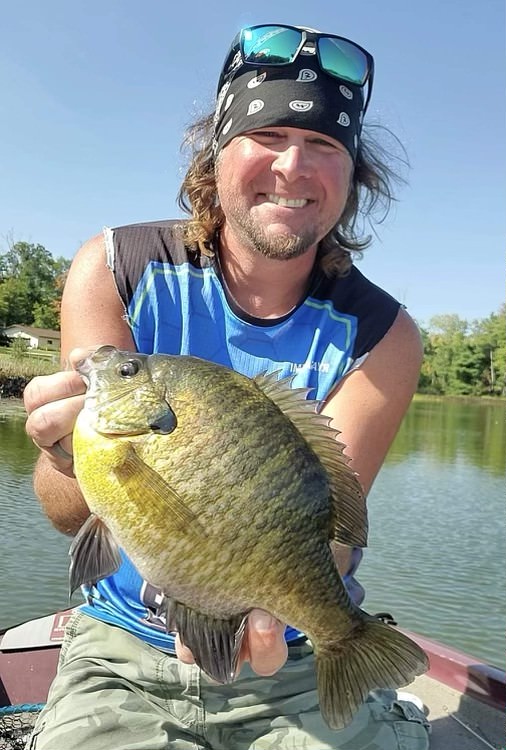Ryan Salemi, founder of Ice Junkies Outdoors is obsessed with big panfish, and few anglers feverishly target big panfish through the entire season like Salemi. The biggest bluegills are a fish that is prized. While a bluegill in general might indeed be the easiest fish to find and catch in the Midwest, hunting down the largest specimens can be a tremendous amount of work with some major game planning adjustments. Because of fishing pressure, genetics and predation… finding the giant bluegill can also be one of fishing’s most difficult tasks. Bluegills are a fish that simply overpopulate and reach sexual maturity at younger ages when beaten down with fishing pressure. A fish that can be vulnerable during the spawn and simply targeted throughout the season by predators with feathers, scales, ice augers or boats. Life is hard if you are a bluegill. Despite the gauntlet that every bluegill must swim through, a big bluegill might be ten years old. Big bluegills are special and often act and live differently than the masses of smaller fish.

Salemi lives in N.W. Wisconsin but much of this advice and experience can be used on many fisheries when targeting big bluegill.
Because of the warm fall this past 2023, Salemi is finding the traditional fall transition periods that are lasting much further into April. Salemi notes a transition or progression to stay on big bluegill through the fall. “The mid depth mud is key right now,” explains Salemi. Look for mudflats in that 8-15 foot of water adjacent to basins. The big fish will move up on these locations to eat and these fish are often bottom orientated.”
These bigger fish in particular are often traveling in small wolf packs of 2-6 fish. When targeting the biggest bluegill, remember that you are typically dealing with much smaller schools and fewer fish. Salemi hunts for these packs of fish with forward facing sonar and casts slip bobbers at specific fish. Typically these mud flat fish can be found within six inches to a foot off the bottom. Salemi adjusts his slip bobber setups accordingly to fish right on the bottom. Salemi uses a lot of the Gulp! Crickets or half of a Gulp! Trout Worm. This is threaded onto a 1/32nd ounce jig with a size 8 hook. Favorite jig color is neon orange. This is used below a Micro Finesse Slip Float. Salemi typically used four pound Frost Mono with these slip float setups.
Salemi stresses the importance of casting ahead of roaming packs of fish and stirring up the mud with the jig by barely making bottom contact. These fish are focused on the bottom eating insect larvae.
This mud flat pattern will slowly fade as water temps slide down into the low fifties. As the fall progresses, this pattern can be day to day. Nice days with sunshine will see fish pull up onto these mud flats out of the basin. Also worth noting that midday to early afternoon is often prime time as the days get a little bit colder. Early mornings can be slow and the bite gets better as the water temps climb slowly through the day.

As fall progresses and water temps creep into the low forties, most of these bluegill will end up roaming the adjacent basin and this is a process or transition that takes several days. With forward facing sonar in particular, an angler can follow these fish and follow this transition.
A few more keys for finding big bluegill? Salemi likes hard to reach lakes. Lakes that require you to walk or portage are prime. Lakes that fly under the radar because of reputation or lakes that winterkilled are prime candidates for finding bigger fish. Larger lakes that have low population densities of bluegill are worth checking. A favorite lake type for Salemi are weed choked lakes that become impossible to boat or fish during much of the summer. Big bluegill are seldom easy.



